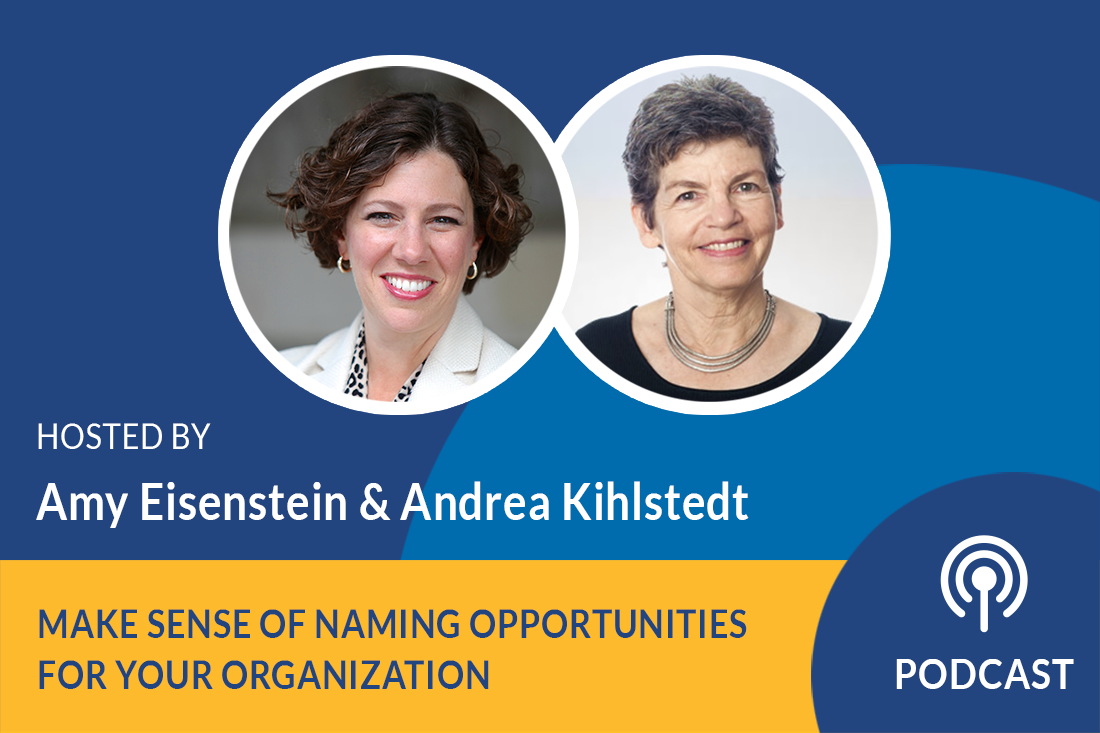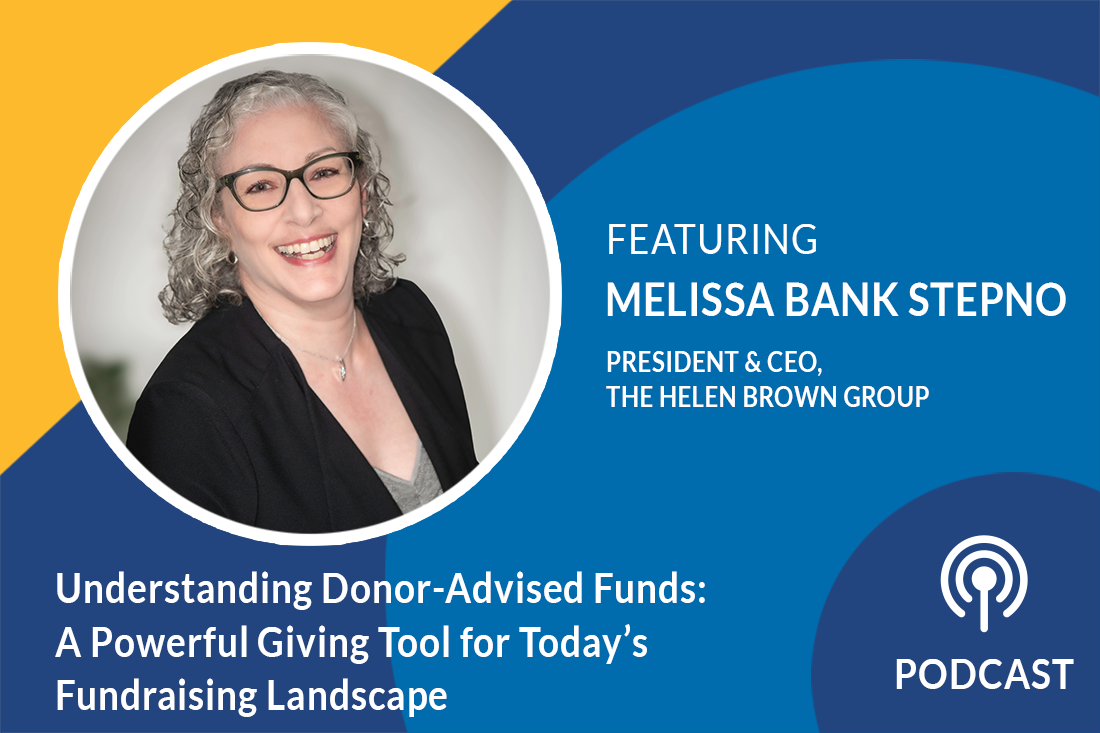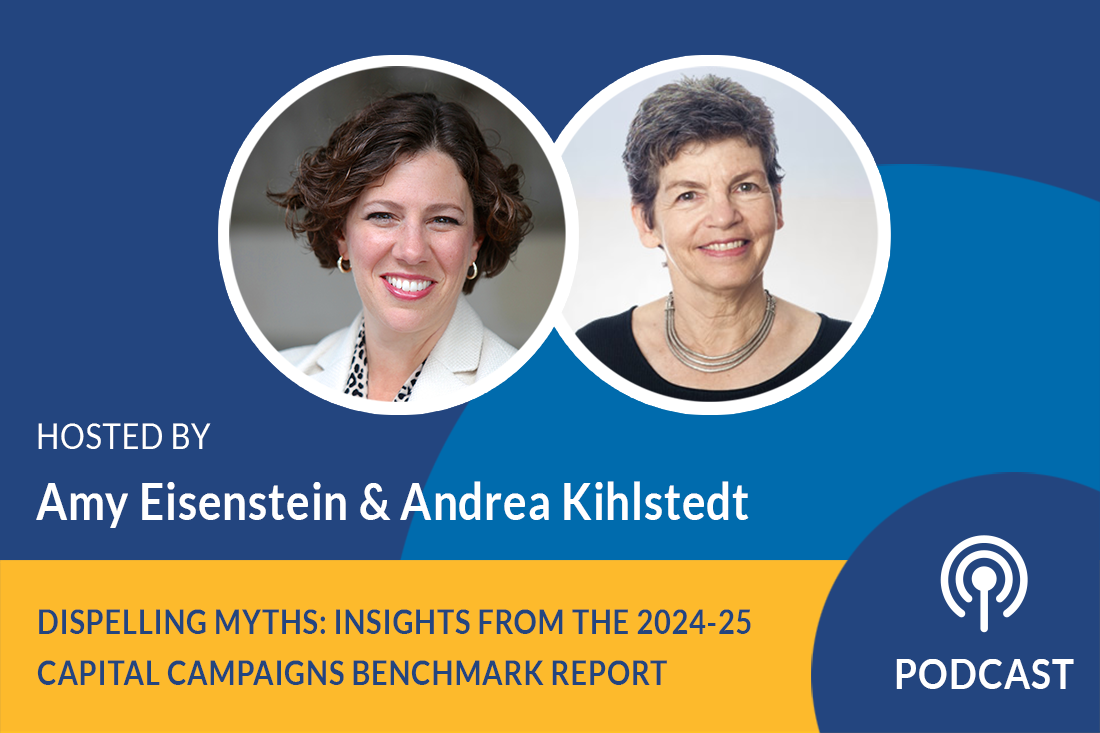Podcast: Make Sense of Naming Opportunities for Your Organization

Season 3, Episode 60
Campaign experts Amy Eisenstein and Andrea Kihlstedt question the traditional practice of naming buildings and room after large-gift donors. While that approach may be right for some organization, it may be worth reconsidering for others.
Listen Now:
Amy Eisenstein:
If you’re getting ready for a capital campaign, you may think that naming opportunities for buildings and other space are a no brainer, but that’s not necessarily the case anymore.
Let’s explore how to do it. And even if you should.
Naming Opportunities with Respect to DEI
Andrea Kihlstedt:
These days, many organizations are thinking about diversity, equity, and inclusion much more constructively and effectively than we have ever done in the past and naming opportunities, it’s an important topic in that regard. Sometimes when I walk around organizations that have named buildings and spaces in honor of donors who have given lots of money, it feels to me as though it’s from a different era, and for some organizations that may no longer feel appropriate. If you have an organization that your very mission is about creating more equity and giving voice to people who don’t have voice, do you really want to give the donor who gives $1 million or $2 or $3 million? Do you want to name your building after that donor? is that still appropriate?
Amy Eisenstein:
It puts an outsized spotlight on what people with lots of financial resources can do even though there’s lots of other people working hard for your organization.
Andrea Kihlstedt:
I think what we want to do is not to tell you that you should or should not continue with that traditional practice, but we want you to have real important conversations in your organization about the practice and decide if your organization wants to have naming opportunities where you will name spaces and rooms and buildings for people just because of the size of the gift that they’re going to make.
Amy Eisenstein:
And I think the conversation before you launch into your campaign is about how you’re recognizing donors and volunteers and in what ways. So I think our point number one is the importance of having a conversation, a constructive, specific strategic conversation with your board, with your committee to see how you want to recognize people, when you’ll recognize them, in what ways, and not just be a given that you do it in the same old, same old way because it’s always been done that way.
Naming Opportunities Are NOT Required
Andrea Kihlstedt:
Now, the second point is this Amy, that we take for granted and many people take for granted that donors who give large amounts of money want to see their names on buildings, they want to name buildings, want buildings named in their honor.
I recently worked on the campaign that decided that naming buildings in honor of people with great wealth was not appropriate for their mission so they came back to me and said, “We don’t want to do this for our campaign.” And we went through the entire campaign, when a donor asked about naming opportunities, they just graciously said, “We’ve decided that everyone will be recognized. We are not going to name our spaces and our buildings in honor of large donors. It’s not in keeping with our mission.” Do you know that entire campaign was a very successful campaign? No donor ever complained and no donor said they wouldn’t give because their name wasn’t going to be on the building.
Think Creatively
Amy Eisenstein:
I think it’s an opportunity to really think creatively. I think the campaign you’re describing, but even if it’s not, was a music building or a performing arts center. And in that case or another case, you might say to a donor:
Instead of putting your name on this room, think of a musician who’s influenced you or that you really appreciate and we’re going to name the room after that famous musician or less famous musician. But we’re going to highlight our mission in that way by turning the attention to our mission rather than specific donors.
So it’s an opportunity really for creativity. You could still name rooms, but it could be the jazz room of a famous jazz player that you love and admire… something like that.
Andrea Kihlstedt:
Of course, yes. As Amy says, if you’re not going to recognize donors by giving size, you really do need to figure out how you’re going to recognize donors. And we’re not suggesting that you shouldn’t steward and recognize donors. Maybe you have a large plaque in your lobby that lists people by giving amounts in that large plaque so that people can see their names in one place.
The question really is, if you want to have a donor’s name on a space or a building that indicates that, that donor might own it in some way because they bought it with their gift, and I think that that’s something that everybody going into a campaign should in the very early stages have meaningful conversations with their board about what practice is appropriate for that organization. You might also have early meaningful conversations with some of your largest donors to see, how important is it to them to have a big naming opportunity in their honor? Their response might surprise you actually.
Amy Eisenstein:
So if you engage your biggest potential donors in the conversation up front, you’ll have a sense of that. I think that’s super important. Alright, what else do we want to talk about with regard to naming opportunities? Other examples of ways that you’ve seen donors be recognized or thanked in non-traditional ways?
Donor Recognition in Other Ways
Andrea Kihlstedt:
There are many ways to do that I think. Today, there are a lot of people who do donor recognition electronically, for example, in a lobby. They’ll have a big electronic screen where they scroll the names of donors. And, of course, you have to think about, well, do we want to list people alphabetically or do we want to list them by giving amount?
- So you can have plaques on the wall.
- You can have electronic screening.
- You can have a donor role on your website where you’re rolling through the people who have given.
- And you can, of course, highlight particular donors who have done remarkable work and remarkable things for your organization in newsletters and other sorts of things.
If there has been someone who has been incredibly important to your organization, who has been a founder of your organization, for example, and who also has happened to give large gifts, you could honor that person in a plaque in your organization. But that’s honoring them not just for their money, it’s honoring them for their role in creating and being part of your organization. I think you need to separate money out by itself. You have to be careful with that.
Amy Eisenstein:
I was going to say, I think that’s such an important point because maybe you can mix your donor recognition plaques with volunteer recognition plaques. So if somebody has been an especially important volunteer, they would get just as big of a plaque as donors. So really starting to think about people who had add value to your organization in a multiplicity of ways.
Andrea Kihlstedt:
These days I’m so interested to see how often now people are recognizing the Native Americans on whose land a facility is. And we need to broaden who we are recognizing and to include people back in history and going forward as well.
So I think these conversations can be lively and important conversations that get to the very essence of who your organization is and that we encourage you to have that conversation. We are not advocating that you not do the traditional model. It may be a right model for you, but just that you seriously consider it. You don’t do it just because it’s always been done.
Amy Eisenstein:
That’s right. I think that we’re of the mindset of get-out-of-the-rut mentality. Don’t just do something because it’s always been done.
Final Thoughts
For some organizations, the traditional way of recognizing donors may be appropriate and that may be the case at your organization. But it may not and so don’t just go in with the assumption that that’s the first thing you need to do is figure out naming opportunities, because there’s a lot of different creative, interesting ways that organizations are starting to recognize donors and volunteers and contributors at all levels across the organization.
Alright, Andrea, I think that is great. We have really, to me, started a conversation that organizations need to run with. We have not finished the conversation by any stretch of the imagination, but hopefully we’ve sparked something for you and your [core] campaign committee.
Alright, so if you want to learn more about this topic, I hope you’ll visit us at capitalcampaignpro.com, where we explore this and all sorts of campaign topics. And if you need help with your campaign or planning or running your campaign, go ahead over to [our website] and sign up for a free strategy session to see what we can do for you. Thank you so much for joining us and we’ll see you next time.



Leave a Comment